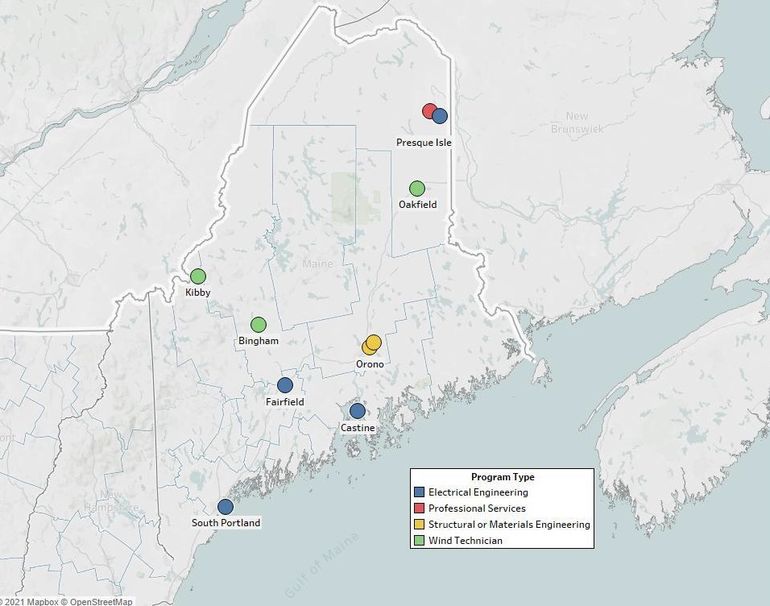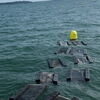Processing Your Payment
Please do not leave this page until complete. This can take a few moments.
- News
-
Editions
View Digital Editions
Biweekly Issues
- December 1, 2025
- Nov. 17, 2025
- November 03, 2025
- October 20, 2025
- October 6, 2025
- September 22, 2025
- + More
Special Editions
- Lists
- Viewpoints
-
Our Events
Event Info
Award Honorees
- Calendar
- Biz Marketplace
New report cites strong job potential in Maine-based offshore wind industry
 Courtesy / BW Research Partnership
The research team identified 10 wind-specific training programs — including engineering and technician roles — in seven Maine institutions.
Courtesy / BW Research Partnership
The research team identified 10 wind-specific training programs — including engineering and technician roles — in seven Maine institutions.
A new report says Maine has the potential to develop a world-class offshore wind workforce capable of operating regionally, nationally and internationally.
And it says Maine has significant training capacity for wind-specific certifications and for related occupations such as welding, electricians and manufacturing necessary for offshore wind.
“Maine Offshore Wind Talent Analysis” was released this week as part of the Maine Offshore Wind Roadmap. The report, developed by BW Research Partnership with stakeholder input, provides an analysis of Maine’s workforce talent resources and applicability to the 117 occupations in the rapidly growing U.S. offshore wind industry.
The analysis focuses on the job creation potential and workforce needs of the sector, and stems from Gov. Janet Mills’s stated goals of creating 30,000 clean energy jobs in Maine by 2030 and becoming carbon-neutral by 2045.
According to the report, the offshore wind industry, both in and outside of Maine, presents a wide variety of job opportunities for Mainers. The industry is rapidly growing across the East Coast, and services ranging from surveying and permitting to construction and installation will be needed from North Carolina to Eastport, the report says.
Key findings
The analysis found that Maine’s existing wind-related workforce is already strong, accounting for more than 1,300 jobs in 2020, or about 10% of Maine’s clean energy workforce.
Maine’s wind energy workforce has seen strong growth in recent years; between 2016 and 2020, the number of workers grew by 7.1%. The sector also demonstrated resiliency through the pandemic, growing 4% between 2019 and 2020.
The research identified 117 occupations expected to be crucial to the development and operation of offshore wind projects. The occupations fall into five project phases: planning and development; manufacturing and assembly; construction and installation; operations and maintenance; and support services.
However, four occupations are understaffed by about 10% and another 40 occupations will likely have some workforce gap.
Still, there’s some potential to transition displaced or unemployed workers from adjacent occupations, or jobs that have similar skillsets, the report says. Among the 12 occupations with the greatest estimated workforce gaps, there are more than 600 people who are estimated to be currently unemployed but worked in adjacent occupations that have similar skills and abilities to the in-demand offshore wind jobs.
Several occupations and industries in Maine are well positioned to provide services in and outside of the state, for both floating and fixed-bottom offshore wind activities, the report says. For example, Maine has the times the national average of zoologists and wildlife biologists, talents lending themselves to surveying, permitting and marine monitoring. Maine also has a high concentration of marine engineers and naval architects — more than eight times higher than the national average.
“These types of occupations suggest that Maine is not only prepared to support relevant offshore wind activities within the state, but support activities across the country as the offshore wind industry grows,” the report says.
Maine’s training providers — including community colleges, apprenticeship programs and partnerships with organized labor – are also well-positioned to serve the industry, although specialized training in offshore-wind-specific skills will be needed.
Recommendations
The report recommends that Maine leverage federal and state funding for pre-apprenticeship and apprenticeship programs that prepare workers for relevant offshore wind occupations. Key to the process, the report says, is ensuring that training programs and workforce initiatives are geared towards developing a workforce that represents all demographics.
For example, the industry could engage with community-based organizations and immigrant community leaders to diversify the workforce and could develop strategies to engage unemployed workers from adjacent occupations.
Other recommendations included:
• Encourage the state to formalize the requirement for relevant certifications.
• Engage K-12 students to enhance the number of students flowing into pipelines for programs relevant to offshore wind occupations.
• Work with existing educational institutions and training providers to prepare to scale and specialize training programs.
• Ensure that offshore wind jobs are high-quality jobs that offer family supporting wages and that the jobs are accessible to a wide variety of Mainers.
• Continue dialogue and outreach to fishermen and mariners.
Mainebiz web partners

The Giving Guide
The Giving Guide helps nonprofits have the opportunity to showcase and differentiate their organizations so that businesses better understand how they can contribute to a nonprofit’s mission and work.
Learn More
Work for ME
Work for ME is a workforce development tool to help Maine’s employers target Maine’s emerging workforce. Work for ME highlights each industry, its impact on Maine’s economy, the jobs available to entry-level workers, the training and education needed to get a career started.
Learn More
Groundbreaking Maine
Whether you’re a developer, financer, architect, or industry enthusiast, Groundbreaking Maine is crafted to be your go-to source for valuable insights in Maine’s real estate and construction community.
Learn more-
The Giving Guide
The Giving Guide helps nonprofits have the opportunity to showcase and differentiate their organizations so that businesses better understand how they can contribute to a nonprofit’s mission and work.
-
Work for ME
Work for ME is a workforce development tool to help Maine’s employers target Maine’s emerging workforce. Work for ME highlights each industry, its impact on Maine’s economy, the jobs available to entry-level workers, the training and education needed to get a career started.
-
Groundbreaking Maine
Whether you’re a developer, financer, architect, or industry enthusiast, Groundbreaking Maine is crafted to be your go-to source for valuable insights in Maine’s real estate and construction community.
ABOUT
NEW ENGLAND BUSINESS MEDIA SITES
No articles left
Get access now
In order to use this feature, we need some information from you. You can also login or register for a free account.
By clicking submit you are agreeing to our cookie usage and Privacy Policy
Already have an account? Login
Already have an account? Login
Want to create an account? Register
Get access now
In order to use this feature, we need some information from you. You can also login or register for a free account.
By clicking submit you are agreeing to our cookie usage and Privacy Policy
Already have an account? Login
Already have an account? Login
Want to create an account? Register






0 Comments